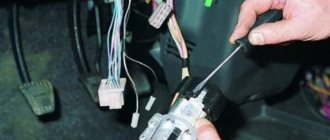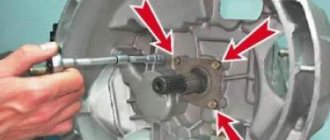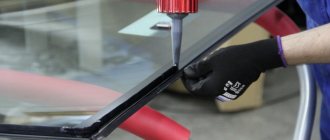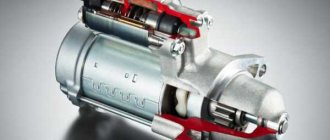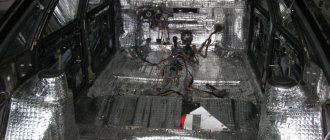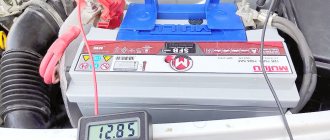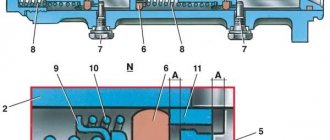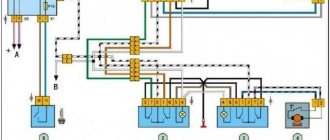Do-it-yourself car battery maintenance, done with high quality, makes it possible to increase its service life by 2–2.5 times, saving money and time.
The need for maintenance is determined by the following factors:
- Over time, charge parameters deteriorate.
- Idle transport with the engine running contributes to the discharge of the car battery.
- Poor quality, untimely care leads to irreversible processes. A failed battery cannot be serviced.
What determines the service life of a battery?
Studying the factors affecting the period of use of batteries allows you to maintain the device in working condition.
Charge level
Frequently discharging the car battery helps reduce the time of use. Experts recommend constantly charging serviced car batteries and replenishing lost charge. But when moving around the city, it is difficult to achieve such a result. After all, the engine periodically starts and turns off. In this case, you can use a mains charger. It is easy to charge the power supply using it.
Temperature
The main influence of temperature is on starting power. To obtain maximum capacity, a temperature of 15 degrees is required. Capacity is lost when the set temperature decreases.
During winter, battery maintenance is performed more frequently. Indeed, when the battery freezes completely or partially, the quality of the electrolyte deteriorates.
Watch a video about battery maintenance in cold weather.
On-board system performance
The condition of car batteries depends on the condition of the electrical network. Therefore, the generator and regulator must be maintained in working order. Otherwise, it will be difficult to operate the battery.
Applying excessively high voltage leads to boiling and overcharging. The electrolyte level gradually decreases. And to increase it you need to add distilled water.
Corrosion processes
It is not difficult to stop corrosion processes. For this purpose, additives and alloying impurities are used. To minimize the likelihood of corrosion, a higher quality electrolyte is required. Refill it if necessary.
Sulfation
Its intensity is reduced if the car battery is charged and serviced in a timely manner.
Sulfation is established using equipment and research.
High level - why it’s dangerous
It seems that we have decided, low is BAD! But is being too tall ALSO BAD? YES - ALSO BAD! But why?
Look - the normal density inside the battery is approximately 1.27 - 1.29 g/cm3 (if we take our working fluids it is approximately 35% sulfuric acid and 65% distilled water). This electrolyte does not freeze at extremely low temperatures (up to -40 degrees Celsius).
If you upset the balance and, say, pour 70% water composition, then our density will drop to 1.22 - 1.25 g/cm3. And such a liquid freezes already at -20, -30 degrees, which is quite common in Russia. Of course, in the summer you most likely won’t experience any problems, but in the winter the battery may freeze, so much so that the case will rupture and you will simply throw away the battery.
So you need to pour exactly as much as needed (within the permissible limits).
Battery maintenance frequency
Maintenance is divided into periodic and diagnostic. Most processes are carried out at home.
In order to understand how to properly service the battery, you need to study all the intricacies.
Periodic maintenance
- Operation of network charging. Before winter, charging is carried out quarterly, at negative temperatures - monthly. Mains charging is used when the power source is completely discharged.
- Use of a load fork to assess general condition.
- Establishing the density of the electrolytic composition. The operation of the battery depends on this.
- Calculation of leakage current. The performance of the power source and the condition of the electrical components depend on this characteristic.
- Desulfation process.
Charging a maintenance-free car battery is carried out according to a special scheme.
Diagnostics
- Measuring the voltage level after disconnecting the source from the power supply.
- Measuring voltage while the engine is running.
- Assessing the condition of the battery at home.
Diagnostics related to checking characteristics, electrolytic fluid and oil levels are performed regularly. Such processes help maintain batteries in working condition.
Cleaning Oxidized Terminals
A very important point, especially if the battery has liquid electrolyte. When starting the engine, the battery delivers hundreds of amperes of current. In this mode, the electrolyte “boils” - the water included in its composition decomposes into hydrogen and oxygen. In serviced batteries, gases escape through holes in the plugs. In maintenance-free ones, they are partially restored in special labyrinths provided in the battery cover, and partially exit through specially provided valves.
Oxygen and hydrogen themselves are harmless, but they are saturated with sulfuric acid vapor, which settles on the battery terminals. As a result, the tips and terminals of the battery oxidize over time, and the contact between them deteriorates. If special measures are not taken regularly, this can look very disastrous. Poor contact means difficult starting, constant undercharging and, as a result, battery failure.
Expert opinion
Alexey Bartosh
Specialist in repair and maintenance of electrical equipment and industrial electronics.
Ask a Question
Important! Very often you can hear the opinion that oxidation of the terminals is a sign of improper operation of the battery. This is not true. Oxidation occurs in any case. Another question is how quickly and intensely this happens. If you have to clean the terminals every month, then yes, it’s worth checking the charging mode and battery condition.
What should we do if the tips and terminals of our battery are oxidized and covered with “frost”? The obvious answer is to get them in order. Moreover, you can do this yourself, without resorting to the help of a specialist. In general terms it will look like this:
- Remove the lugs from the terminals.
- We thoroughly wash both of them with a strong solution of baking soda in water. This will help neutralize the acid.
- Using a wire brush or sandpaper, clean the tips and terminals until they shine.
- Thickly coat the terminals with any thick lubricant (salidol, cyatim, technical petroleum jelly, etc.).
- We install the tips in place and once again coat everything, including the tips, with thick lubricant.
If you want to get more detailed information about cleaning battery terminals, then read the article “How and with what to clean battery terminals from oxidation.”
Car battery maintenance rules
The performance of vehicles depends on the state of the power source. Therefore, battery maintenance must be carried out in stages.
Visual assessment
The battery is inspected 2-3 times a month if the vehicle is actively used. Salt, oil stains and electrolyte leaks are removed from the body. For cleaning, you can use a solution that includes baking soda.
Electrolytic composition leaks contribute to the formation of a film that facilitates current conduction and rapid self-discharge. Terminals and terminals are treated with anti-corrosion mixtures. Before processing, any remaining rust, dust and contaminants are removed from these elements.
Voltage level measurements
The degree of charge is established using a multimeter with a closed and open circuit. Polarity must be observed when placing terminals. European and domestic devices differ in the placement of negative and positive terminals.
The voltage of a fully charged battery is 12.6 V. You cannot operate or maintain a battery that is not fully charged. After all, the sulfation process will proceed faster.
The voltage is also measured with the engine on, the stove connected and the on-board network connected. This mode implies a voltage of 13–14 V.
Such measurements are necessary to establish the condition of the generator. Charging the battery depends on its performance. If the voltage is too low, the charge will not be fully replenished.
Lack of voltage contributes to the rapid consumption of distilled water. In order to correct the situation, you need to test and repair the car's electrical system.
Electrolyte
You can evaluate the level of electrolytic composition without dismantling the battery. The procedure is carried out after the device is fully charged.
- Serviced battery. To determine the electrolyte level, holes located on the cans are first opened. A plastic tube is lowered into the hole until its edge touches the plates. The resulting parameter must be at least 10 mm. In this case, it is very important to know how to top up the electrolytic composition.
- Maintenance free battery. To check the electrolyte in the battery, appropriate marks are used. For more information on how to maintain a maintenance-free battery, contact a professional.
Additionally, the degree of density of the electrolyte is assessed. A hydrometer is used for measurements. To adjust the density level, distilled water and a new electrolyte are used. Before pouring the composition, the degree of density is measured.
Leakage current
Excessively high leakage current prevents constant charge restoration and contributes to rapid discharge of the battery. This parameter can be measured using a multimeter. After such a check, battery maintenance will be simplified.
Charging the battery
Constant voltage charging is performed quarterly. In winter, care and maintenance are performed more often. After all, the battery is exposed to negative temperatures.
When the power supply is completely discharged, an emergency charge is required. Such situations arise due to:
- Headlights on.
- Listening to music for a long time.
- Long downtime.
The battery should only be charged at constant current.
Assessing the condition of the battery
For these purposes, a load fork is used, with the help of which the maximum load is simulated when the engine is running. Activities like this are easy to do on your own.
Low level - why it’s dangerous
It is dangerous for many reasons, I will try to explain it simply and quickly:
- If the level drops, it means the water is evaporating. The density of sulfuric acid increases (since it does not go anywhere). This has a very negative effect on the plates themselves; they simply begin to deteriorate faster.
- If the acid concentration is high, this can lead to an accelerated sulfation process of the plates
- The upper part of the plates is exposed - and this also negatively affects them when charging. They simply warm up and can crumble.
- If there is not enough electrolyte (the plates are exposed), the battery capacity drops accordingly, meaning you simply won’t start the car.
From my own experience, I will say that batteries with bare plates do not last long; as a rule, they crumble or become sulfated within 3 to 6 months of use. Therefore, it is very important to add liquid to the required values!
How to maintain maintenance-free batteries?
A maintenance-free battery requires care. Maintenance of such a battery is simple.
- Inspection of the hull. During the process, the general condition is monitored, defects, damage, and leaks of the electrolytic mixture are identified.
- Inspection and repair of drainage channels. They are cleaned of dirt and dust.
- Visual inspection.
- Detection of leakage of electrolytic composition.
- Neutralization of acidic and alkaline environments.
- Treatment of inputs and contacts with lubricant. Such actions help extend the service life and prevent destruction.
- Testing the functionality of the terminals. The level of charge received from the generator depends on the results.
It is not necessary to add electrolyte to a maintenance-free battery.
How much should you add?
If you have a serviceable battery, that is, you can physically unscrew the plugs and see the plates, whether they are exposed or not, this is one situation.
But if you have a maintenance-free option, then adding to it is much more difficult (more on that below).
Let's take a standard situation - the plugs have been unscrewed, and the plates are exposed (the upper part sticks out above the liquid). So how much to pour, to the fullest (under the cork) or what?
DEFINITELY NOT UNDER THE COVER! It's too much. Take a bottle of distilled water (you can prepare it yourself ) and add it about 1 - 1.5 cm above the plates. That is, the overall composition should cover them exactly by this value.
By the way, on many batteries there are special marks - lower and upper, it is within these boundaries that the level should be. However, now they are applied to the body less and less.
Ideally, after adding water, you need to recharge the battery and measure its density. It should be approximately 1.27 g/cm3.
Now let’s take the situation with a maintenance-free battery - as I wrote, there are no plugs on top, but distillate needs to be added somehow! But how? I already have an article (read it informatively).
However, this is difficult to achieve using simple methods. AND never tear off the lid on top, this is not correct, it contains labyrinths that absorb gases evaporating from the cans. If it is violated, the battery will no longer be maintenance-free.
The most effective way is to take a thin drill and drill holes above the jars, approximately to the normal electrolyte level. Next, pump water in there with a syringe, and then solder these holes with a soldering iron. Well, actually charging.
Now let's watch a small but useful video.
I’ll end here, I think my material was useful to you. Sincerely yours, AUTOBLOGGER.
( 9 votes, average: 4.11 out of 5)
Features of caring for serviced batteries
Maintenance includes the following procedures:
- Assessment of the degree of fastening reliability. If necessary, bolts and nuts are fixed.
- Terminals and clamps are cleaned of oxides and rust. To prevent the formation of corrosion, parts are treated with lubricants.
- Visual and instrumental check of the level of electrolytic composition. For testing, improvised means and special tubes are used. When the electrolyte level decreases, the jars are filled with distilled water and the prepared electrolyte. You can buy them in stores.
- Determination of electrolyte density. The charge level also depends on this indicator. Excessively low readings indicate a poor charge.
- Checking battery performance using a load fork.
Filling with electrolyte is carried out only if there are smudges. This procedure includes a number of processes. The performance of the on-board system, main components and the car depends on the correctness of their implementation.
Increasing electrolyte density
Let's look separately at how to increase density. After all, a low level reduces the voltage and makes it difficult to start the car engine.
- First you need to measure the density in each battery bank and compare it with the norm for the climate zone.
- Increasing the density occurs by adding an electrolyte of higher density. To do this, use a pear to remove the old solution and fill it with a new one, half the volume of the old one.
- Shake the battery without turning it over to mix the liquids.
- A control measurement of density is carried out, repeating the procedure if necessary until the required values are achieved.
- We fill the remaining volume with distilled water.
Security measures
Maintenance of car batteries is carried out in accordance with some recommendations and safety measures:
- Before carrying out work, prepare glasses and gloves made of durable material.
- All events are held in premises equipped with ventilation systems and communications.
- When working with acids and alkalis, precautions must be taken.
- Batteries should be placed on a clean and dry surface.
- Contact between the skin and the electrolytic composition should be avoided.
The functioning of all mechanisms and systems of the vehicle depends on the performance of the battery. The energy generated by the power source is used to start the engine, recharge electronic components and the on-board network.
It is not difficult to prevent rapid battery failure. This requires maintenance of the power supply.
What should you add inside?
So, let's move on to the most interesting part. BUT first, a little reminder, many people mistakenly think that you need to add ready-made electrolyte inside , which is sold in automotive or specialty stores. BUT THIS IS NOT SO!
As I already said above, it is water that evaporates from the cans, and it is water that needs to be added to the cans, BUT NOT ELECTROLYTE!
Once again I want to repeat to everyone, it is the aqueous solution that evaporates, but not the acid! If you add electrochemical fluid to the level, then you will raise the density to a high level, say 1.32 - 1.35 g/cm3, the plates from such a concentration wear out much faster, and sulfates are also formed!
Therefore, only distilled water, and only a certain level.
Questions on the topic
Filter:AllOpenSolvedClosedWaiting for response
Where is the backup battery located on the Mercedes-Benz E-Class? Is it possible to change it yourself? Answered by User answered 9 months ago
35 views 1 answer. 0 vote.
When parked for more than 3-5 days, the battery is discharged. With what it can be connected? Answered by User answered 9 months ago
37 views 1 answer. 0 vote.
Is it possible to install a larger capacity battery on the Hyundai Solaris? Answered by User answered 9 months ago
30 views 1 answer. 0 vote.
What kind of battery is installed on? Answered by User answered 9 months ago
25 views 1 answer. 0 vote.
How to install a replacement battery on a Chevrolet Cruze? Answered by User answered 9 months ago
26 views 1 answer. 0 vote.
What is the cause of the malfunction of the Mercedes-Benz E-Class backup battery? Answered by User answered 9 months ago
32 views 1 answer. 0 vote.
The UAZ 469 battery is not charging. Answered by User answered 9 months ago
34 views 1 answer. 0 vote.
Tell me which battery to install on Mazda 6 2008? Answered by User answered 9 months ago
27 views 1 answer. 1 vote.
How to initialize the battery in Mazda CX-7? Answered by User answered 9 months ago
24 views 1 answer. 0 vote.
Ask a Question
Practical advice for motorists
Sometimes the battery says that it is maintenance-free, but strangely enough, there is access to the banks. In this case, you can carefully add distilled water into the holes. Perhaps, by writing the word “maintenance free” on the battery case, the manufacturers expected that the amount of electrolyte would be enough for the entire service life of the battery. But this is not always the case. False covers, when unscrewed, may turn out to be real ones, so it is recommended to check them more carefully.
After charging the battery, the electrolyte should be allowed to cool slightly before taking its density readings, because hot electrolyte may give inaccurate readings.
In winter, when the temperature is especially low, you need to try to make the process of operating the starter and starting the engine as easy as possible. According to the rules, the starter should not operate for more than 15 seconds during startup. If you fail to start the car in the first attempt, you must take a 1- or better 2-minute pause and try starting again. It is also possible to “boost” the battery by turning on the high beam headlights for 10 seconds, and for a faster start, fully depress the clutch.
By following simple but necessary tips for car maintenance, you can increase their service life, and then you won’t have to send your car in for repairs often. Proper and regular care of not only the car, but also its battery will help the driver get maximum pleasure and benefit when operating one of the most important means of transportation.



